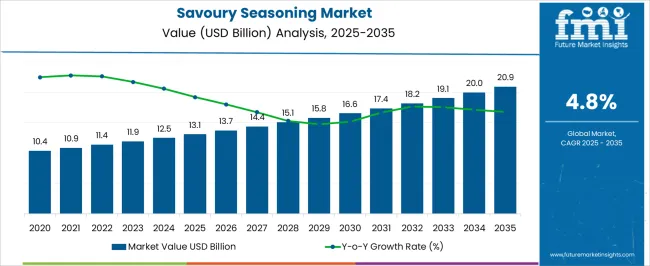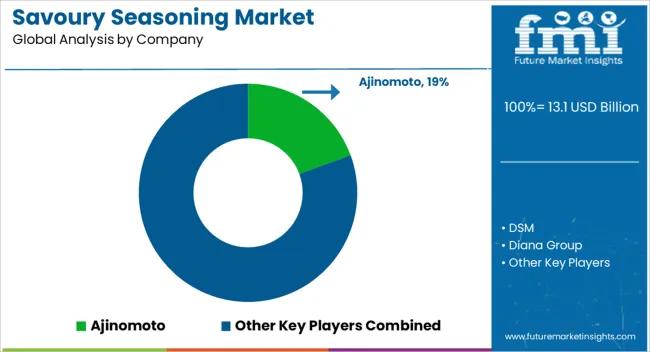The Savoury Seasoning Market is estimated to be valued at USD 13.1 billion in 2025 and is projected to reach USD 20.9 billion by 2035, registering a compound annual growth rate (CAGR) of 4.8% over the forecast period.
| Metric | Value |
|---|---|
| Savoury Seasoning Market Estimated Value in (2025 E) | USD 13.1 billion |
| Savoury Seasoning Market Forecast Value in (2035 F) | USD 20.9 billion |
| Forecast CAGR (2025 to 2035) | 4.8% |
The Savoury Seasoning market is experiencing steady growth due to rising consumer preference for convenient, flavorful, and ready-to-use culinary solutions. The current market scenario reflects strong adoption of products that enhance taste profiles in processed foods, ready-to-eat meals, and home cooking applications. The market growth has been supported by increasing urbanization, changing lifestyles, and a rising inclination toward global cuisines, which is driving the demand for versatile seasoning solutions.
Rising investments in food processing and packaged food industries are enabling broader availability of these products in retail channels. Technological advancements in formulation and packaging, along with the ability to maintain flavor and freshness, are further facilitating market expansion.
Additionally, the growing interest in health-conscious eating is encouraging manufacturers to innovate products with natural ingredients, clean labels, and balanced taste profiles The market outlook remains positive as consumers increasingly seek convenience without compromising on flavor, and manufacturers continue to introduce innovative blends that cater to evolving culinary preferences across regions.
The savoury seasoning market is segmented by nature, product type, application, end user, distribution channel, and geographic regions. By nature, savoury seasoning market is divided into Conventional and Organic. In terms of product type, savoury seasoning market is classified into Savoury Seasoning Blends (Mixed), Savoury Seasoning Salt And Salt Alternative, Savoury Seasoning Herb, and Savoury Seasoning Spices. Based on application, savoury seasoning market is segmented into Processed Foods And Ready-To-Eat Meal, Chilled, Ambient, Frozen, Snacks, Meat And Seafood, Spreads, Seasonings, Dressing, Soups And Sauces, and Others. By end user, savoury seasoning market is segmented into Food Manufacturer, Retail/Household, and Food Service Provider. By distribution channel, savoury seasoning market is segmented into B2B, B2C, Hypermarkets/Supermarkets, Convenience Stores, Small Groceries, Specialty Stores, and Online Retail. Regionally, the savoury seasoning industry is classified into North America, Latin America, Western Europe, Eastern Europe, Balkan & Baltic Countries, Russia & Belarus, Central Asia, East Asia, South Asia & Pacific, and the Middle East & Africa.
The Conventional nature segment is expected to hold 64.80% of the Savoury Seasoning market revenue share in 2025, making it the leading segment. This dominance is being driven by strong consumer trust in traditional ingredients and flavor profiles that have been widely accepted for decades. Adoption has been reinforced by the wide availability of conventional seasonings across retail, foodservice, and online distribution channels.
The segment has benefited from long-standing supply chain networks and the ability to maintain consistent quality at scale. Furthermore, conventional products are often cost-effective compared to alternative offerings, making them attractive for both households and commercial food manufacturers.
The preference for familiar taste experiences continues to underpin growth, and manufacturers have leveraged this trust by expanding their range of conventional seasoning blends Future opportunities are expected to arise from product innovation within conventional formulations, such as enhanced flavor profiles and functional attributes, which can drive continued adoption without straying from the core nature of traditional seasonings.
The Savoury seasoning blends product type is projected to capture 38.50% of the overall market revenue in 2025, emerging as the leading product category. This growth is being fueled by the demand for ready-to-use blends that simplify meal preparation while delivering complex and consistent flavors. The segment has gained traction due to its versatility, allowing both home cooks and commercial food producers to enhance taste without extensive culinary expertise.
The convenience offered by pre-mixed seasonings reduces preparation time and supports consistency across recipes, which is critical for processed food and ready-to-eat meal manufacturers. The popularity of international cuisines and fusion cooking has further reinforced the demand for blended seasonings, as consumers seek to replicate restaurant-style flavors at home.
Moreover, food manufacturers are increasingly adopting these blends to streamline production processes while ensuring flavor quality The segment is expected to maintain leadership through continuous innovation in blends, packaging convenience, and flavor customization tailored to regional taste preferences.
The Processed foods and ready-to-eat meal application segment is anticipated to hold 41.60% of the Savoury Seasoning market revenue share in 2025, positioning it as the largest end-use segment. This growth is being driven by the rising consumption of packaged foods and the increasing demand for convenient meal solutions, particularly among urban and working populations.
Software-defined seasonings and seasoning blends have enabled manufacturers to deliver consistent taste profiles in large-scale production, enhancing product appeal and customer satisfaction. The segment’s expansion has been reinforced by the growing preference for ready-to-eat options in both retail and foodservice channels.
Additionally, the incorporation of seasoning solutions in processed food products allows for faster preparation, longer shelf life, and improved flavor retention, which aligns with modern consumer lifestyles As demand for convenience continues to rise alongside changing dietary habits, the processed foods and ready-to-eat meal segment is expected to remain a key driver for the Savoury Seasoning market, encouraging innovation in both product formulation and application techniques.
Consumers have a growing preference for strongly flavored foods. Seasoning is an integral part of cuisine as it is responsible for adding aroma and taste to the food. The seasoning used chiefly in snacks or other savoury products to enhance the flavor of food are referred as savoury seasoning.
The savoury seasonings include herbs, spices and seasoning salt which add-ons the nutritive, aromatic and taste profile of the food. Attributable to globalization combined with developing impact of western nations, the savoury seasoning market has grown significantly. Global savoury seasoning market is growing immensely due to the rising number of consumers considering seasoning to supplement their meals with better palates. Another motivation for the growth of savoury seasoning market is the preference of consumers for homemade seasonings due to the curative nature associated with them.

| Country | CAGR |
|---|---|
| China | 6.5% |
| India | 6.0% |
| Germany | 5.5% |
| France | 5.0% |
| UK | 4.6% |
| USA | 4.1% |
| Brazil | 3.6% |
The Savoury Seasoning Market is expected to register a CAGR of 4.8% during the forecast period, exhibiting varied country level momentum. China leads with the highest CAGR of 6.5%, followed by India at 6.0%. Developed markets such as Germany, France, and the UK continue to expand steadily, while the USA is likely to grow at consistent rates. Brazil posts the lowest CAGR at 3.6%, yet still underscores a broadly positive trajectory for the global Savoury Seasoning Market. In 2024, Germany held a dominant revenue in the Western Europe market and is expected to grow with a CAGR of 5.5%. The USA Savoury Seasoning Market is estimated to be valued at USD 4.8 billion in 2025 and is anticipated to reach a valuation of USD 7.2 billion by 2035. Sales are projected to rise at a CAGR of 4.1% over the forecast period between 2025 and 2035. While Japan and South Korea markets are estimated to be valued at USD 682.8 million and USD 450.8 million respectively in 2025.

| Item | Value |
|---|---|
| Quantitative Units | USD 13.1 Billion |
| Nature | Conventional and Organic |
| Product Type | Savoury Seasoning Blends (Mixed), Savoury Seasoning Salt And Salt Alternative, Savoury Seasoning Herb, and Savoury Seasoning Spices |
| Application | Processed Foods And Ready-To-Eat Meal, Chilled, Ambient, Frozen, Snacks, Meat And Seafood, Spreads, Seasonings, Dressing, Soups And Sauces, and Others |
| End User | Food Manufacturer, Retail/Household, and Food Service Provider |
| Distribution Channel | B2B, B2C, Hypermarkets/Supermarkets, Convenience Stores, Small Groceries, Specialty Stores, and Online Retail |
| Regions Covered | North America, Europe, Asia-Pacific, Latin America, Middle East & Africa |
| Country Covered | United States, Canada, Germany, France, United Kingdom, China, Japan, India, Brazil, South Africa |
| Key Companies Profiled | Ajinomoto, DSM, Diana Group, Givaudan, Vedan International, ADM, Associated British Foods, Symrise, Tate & Lyle, Sensient Technologies, and CP Ingredients |
The global savoury seasoning market is estimated to be valued at USD 13.1 billion in 2025.
The market size for the savoury seasoning market is projected to reach USD 20.9 billion by 2035.
The savoury seasoning market is expected to grow at a 4.8% CAGR between 2025 and 2035.
The key product types in savoury seasoning market are conventional and organic.
In terms of product type, savoury seasoning blends (mixed) segment to command 38.5% share in the savoury seasoning market in 2025.






Our Research Products

The "Full Research Suite" delivers actionable market intel, deep dives on markets or technologies, so clients act faster, cut risk, and unlock growth.

The Leaderboard benchmarks and ranks top vendors, classifying them as Established Leaders, Leading Challengers, or Disruptors & Challengers.

Locates where complements amplify value and substitutes erode it, forecasting net impact by horizon

We deliver granular, decision-grade intel: market sizing, 5-year forecasts, pricing, adoption, usage, revenue, and operational KPIs—plus competitor tracking, regulation, and value chains—across 60 countries broadly.

Spot the shifts before they hit your P&L. We track inflection points, adoption curves, pricing moves, and ecosystem plays to show where demand is heading, why it is changing, and what to do next across high-growth markets and disruptive tech

Real-time reads of user behavior. We track shifting priorities, perceptions of today’s and next-gen services, and provider experience, then pace how fast tech moves from trial to adoption, blending buyer, consumer, and channel inputs with social signals (#WhySwitch, #UX).

Partner with our analyst team to build a custom report designed around your business priorities. From analysing market trends to assessing competitors or crafting bespoke datasets, we tailor insights to your needs.
Supplier Intelligence
Discovery & Profiling
Capacity & Footprint
Performance & Risk
Compliance & Governance
Commercial Readiness
Who Supplies Whom
Scorecards & Shortlists
Playbooks & Docs
Category Intelligence
Definition & Scope
Demand & Use Cases
Cost Drivers
Market Structure
Supply Chain Map
Trade & Policy
Operating Norms
Deliverables
Buyer Intelligence
Account Basics
Spend & Scope
Procurement Model
Vendor Requirements
Terms & Policies
Entry Strategy
Pain Points & Triggers
Outputs
Pricing Analysis
Benchmarks
Trends
Should-Cost
Indexation
Landed Cost
Commercial Terms
Deliverables
Brand Analysis
Positioning & Value Prop
Share & Presence
Customer Evidence
Go-to-Market
Digital & Reputation
Compliance & Trust
KPIs & Gaps
Outputs
Full Research Suite comprises of:
Market outlook & trends analysis
Interviews & case studies
Strategic recommendations
Vendor profiles & capabilities analysis
5-year forecasts
8 regions and 60+ country-level data splits
Market segment data splits
12 months of continuous data updates
DELIVERED AS:
PDF EXCEL ONLINE
Seasoning Filling System Market Size and Share Forecast Outlook 2025 to 2035
Seasoning Market Size and Share Forecast Outlook 2025 to 2035
Meat Seasonings Market Size and Share Forecast Outlook 2025 to 2035
APAC Savory Ingredients Market Analysis – Trends & Forecast 2016-2026
The Europe Seasoning Market is segmented by product, end-use, brand and country through 2025 to 2035.
Poultry Seasoning Market Size, Growth, and Forecast for 2025 to 2035
Market Positioning & Share in the Oregano Seasoning Industry
Demand for Seasoning Filling System in USA Size and Share Forecast Outlook 2025 to 2035

Thank you!
You will receive an email from our Business Development Manager. Please be sure to check your SPAM/JUNK folder too.
Chat With
MaRIA